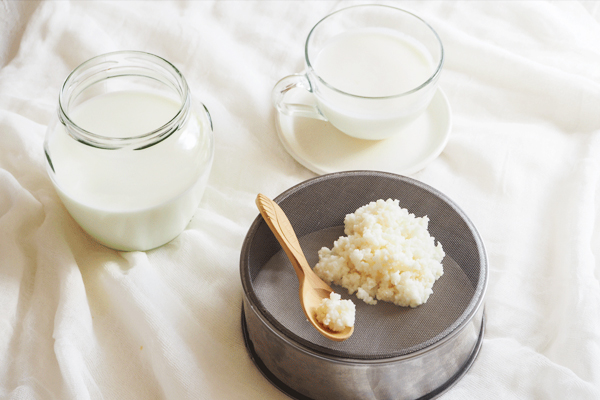DIY Kefir – Superfood Probiotic (Milk or Water Recipes)

If you have access to a television, chances are you have seen the commercials for the yogurt that claims to make you more “regular.” You might wonder how a yogurt can have this effect on the body. The answer? Probiotics.
Until modern times, most cultures incorporated some sort of fermented, probiotic food into their diet as a matter of course. Unfortunately, as we became more modernized, we learned about bacteria and, in fear, began sterilizing everything we come into contact with in our first world lives. We also began to shy away from foods that have been fermented, even though they had been eaten without a problem for generations. Maybe it was a matter of health concern, or perhaps it was a matter of convenience. After all, “modern” first-world eating often relies on shelf-stable foods that are highly processed and, as a result, lifeless. Removing the beneficial probiotic foods has left many people unarmed in the fight against bad bacteria and other flora in the gut. Yogurt products and others like them are an attempt to add probiotics back into the diet and get more healthy gut flora to help win the battle for good health.
Adding probiotics into the diet is one way to balance the good/bad bacteria ratio in the gut. When the good bacteria are on the winning side, the gut tends to function more normally. Additionally, the immune system is strengthened (did you know that about 85 percent of the immune system is in the gut?) and often upper digestive issues can be alleviated without the use of antacids or prescription drugs.
Where Do I Get Probiotics?
There are many avenues one can take to get probiotics into their system. You may purchase the advertised yogurt or the pills that make these health claims, or you can choose to make your own probiotics. Freshly made probiotics can be easy to make and cost substantially less than a similar product from the grocery store. Even more importantly, the probiotic foods you make at home will have far more beneficial live bacteria than products that have been sitting a long while at the store.
What Foods Are Considered Probiotic?
Some of the probiotic foods that you can make at home for little cost are yogurt, milk kefir, water kefir, and fermented foods such as pickles, sauerkraut, and kimchi. Another option for a homemade source of probiotics is kombucha tea.
When I first began learning how to make my own probiotics, I started with making yogurt. As a young mother of three, I found yogurt making to be a challenge. It is not particularly hard to make, but the timing and temperature gauging were hit-and-miss at times with children calling for my attention. I was relieved to eventually discover that there was an easier option—milk kefir—and I have made it instead of yogurt for a few years now.
Milk Kefir—It’s So Easy!
For the purpose of this article, I will share how I make my milk kefir, as I feel it is the easiest of the homemade probiotics that you can make.
Getting Started with Milk Kefir Grains
To make milk kefir, you will need to get your hands on some milk kefir grains. These may be purchased online, or you may be able to find someone local to you that can spare a few. I acquired my first kefir grains from an online friend. It doesn’t take many. I began my first batch with about a half-tablespoon of kefir grains. A tablespoon would have been better, but I just started using less milk than I would usually use.
Milk kefir grains resemble small cauliflower florets, as they are white, somewhat firm, and rubbery to the touch. The longer you make your milk kefir, the more your grains will grow, and you will have extra to either save for a later time, as backup in case something happens to your other grains, or to give to a friend.
The Secret “Survival Vitamin” You Should Buy And Bury…
Keep It Clean
Cleanliness is important, no matter what you are fermenting. Be sure to use clean dishes and utensils. You may reuse the jar you use to make kefir in, but it is wise to wash it every so often, as kefir tends to dry on the upper areas of the jar the longer when it is reused without washing. Also, be careful not to allow metal to come into contact with the kefir for any extended amount of time, as it can be reactive and cause an off flavor in the finished product.

How To Make Milk Kefir
Items you will need:
Clean quart size jar
Jar lid or a clean cloth and string or rubber band
Plastic spoon
Milk
Kefir grains (about a tablespoon, but more or less is fine)
Fine mesh colander (preferably not metal)
Container to strain kefir into
Instructions:
- Place your kefir grains in the jar.
- Pour two cups milk over the grains and gently stir.
- Place lid on jar, but do not tighten. Alternatively, place a clean cloth over lid and secure it in place. The idea is to let air escape as the kefir ferments and to keep insects out.
- Allow the jar to sit at room temperature for about twenty-four hours. The longer it sits, the sourer it will become. You can adjust the fermenting time to your preferences.
- After twenty-four hours, the kefir grains should have had enough time to make the milk into kefir. If the grains were dormant, you might need to repeat this process before the kefir is truly fermented. The grains will “wake up” and start behaving normally now that they have a food supply. The first batch or two after the grains have been dormant may need to be thrown out.
Once your kefir grains have made kefir, follow these steps:
- Place a colander over container.
- Pour the milk kefir through the colander into the container, catching the kefir grains. Depending on thickness, you may need to stir the kefir or thump the colander a bit to make it strain through.
- Return the kefir grains to the jar, pour in two cups milk, and cover as before.
- Allow the jar to sit twenty-four hours to make kefir for the next day.
- Your kefir in the container is ready to consume as is, or it may be refrigerated for later use. If you or your loved one has issues digesting lactose, the kefir may sit another twenty-four hours at room temperature without the grains in it. This will allow the existing bacteria to further digest the lactose in the milk kefir, making it much less likely to cause digestive issues.
I’ve Made The Kefir—Now What Do I Do With It?
Straight kefir can be too strong for some people. Try it and see if you like it. Some ways that I personally use my kefir are chilled and drank straight or with juice added, added to smoothies, and blended with fresh or frozen fruit and poured into popsicle molds. To get the health benefits of the probiotics, you will want to consume it in an unheated state. Heat will kill the probiotics.
Sometimes kefir will separate, and it is easy to pour off the whey to use to soak grains overnight or for fermenting other foods, such as oatmeal or pancake batter, before cooking in the morning. Soaking grains helps to boost their nutritional content and availability to the body as it aids in their digestion.
If You Have Extra Kefir Grains…
If you find that you have too many milk kefir grains and your kefir is ready too quickly, it is time to either add more milk than you usually use or to remove some of your kefir grains. Extra kefir grains may be stored in a jar with milk and placed in the refrigerator. The coolness of the refrigerator will slow the fermentation process. Check on it every few weeks and switch out the milk if needed.
Alternatively, you may dehydrate your extra kefir grains and keep them in a jar in a cool place until such time that you are ready to rehydrate them and begin again. Dehydrated milk kefir grains only have about a 40 percent viability rate, according to some sources, so this would be my last choice unless I had a ton of extra grains. To dehydrate, rinse grains with well water or spring water (do NOT use chlorinated water), then spread them on a clean paper towel to dry. When dry, the grains should be hard and yellow in color. They may also be dried in an Excalibur dehydrator on the absolutely lowest setting until completely dry. After they are dried, store in a cool place or in the refrigerator or freezer. Obviously, if they are dried, you will not have to worry about feeding them.
I would encourage you to try adding some type of probiotics to your diet. Pick a source and let us know if you notice any benefit. I suspect we might all benefit from a little bit more culture in our lives.
In case you missed it:

Milk Kefir—It’s So Easy!




